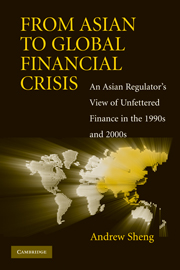 From Asian to Global Financial Crisis
From Asian to Global Financial Crisis Book contents
- Frontmatter
- Contents
- List of Figures
- List of Tables
- Acknowledgements
- Introduction
- 1 Things Fall Apart
- 2 Japan and the Asian Crisis
- 3 The Beam in Our Eyes
- 4 Banking: The Weakest Link
- 5 Washington Consensus and the IMF
- 6 Thailand: The Karma of Globalization
- 7 South Korea: Strong Body, Weak Heart
- 8 Malaysia: The Country That Went Its Own Way
- 9 Indonesia: From Economic to Political Crisis
- 10 Hong Kong: Unusual Times Need Unusual Action
- 11 China: Rise of the Dragon
- 12 From Crisis to Integration
- 13 The New World of Financial Engineering
- 14 What's Wrong with Financial Regulation?
- 15 The Global Financial Meltdown
- 16 A Crisis of Governance
- From Asian to Global Crisis: Chronology of Notable Events
- Abbreviations and Acronyms
- Bibliography
- Index
5 - Washington Consensus and the IMF
Published online by Cambridge University Press: 05 June 2012
- Frontmatter
- Contents
- List of Figures
- List of Tables
- Acknowledgements
- Introduction
- 1 Things Fall Apart
- 2 Japan and the Asian Crisis
- 3 The Beam in Our Eyes
- 4 Banking: The Weakest Link
- 5 Washington Consensus and the IMF
- 6 Thailand: The Karma of Globalization
- 7 South Korea: Strong Body, Weak Heart
- 8 Malaysia: The Country That Went Its Own Way
- 9 Indonesia: From Economic to Political Crisis
- 10 Hong Kong: Unusual Times Need Unusual Action
- 11 China: Rise of the Dragon
- 12 From Crisis to Integration
- 13 The New World of Financial Engineering
- 14 What's Wrong with Financial Regulation?
- 15 The Global Financial Meltdown
- 16 A Crisis of Governance
- From Asian to Global Crisis: Chronology of Notable Events
- Abbreviations and Acronyms
- Bibliography
- Index
Summary
The Consensus is that there is no Consensus.
~ AnonymousIf we were to look at all the actors on the Asian financial crisis drama, we cannot ignore the role of Japan. But on a global scale, the real superpower is undisputedly the United States. In 1996 the U.S. GDP was US$7.8 trillion, nearly 60 percent larger than Japan's and nine times larger than China. Asia's rise and fall had a lot to do with the United States, as the single largest Asian trading partner. Asia relied so much on the U.S. economy that it used to be said that if the United States were to sneeze, Japan would catch a cold and the rest of Asia would catch pneumonia.
The world was fortunate that when Asia got into trouble in 1997, the U.S. economy was strong and prosperous. In 1950 the United States accounted for over 27 percent of world GDP and as much as 38 percent of world exports. In the postwar era, the United States was such a dominant economic and military power that the U.S. dollar accounted for more than 55 percent of global transactions. Like Rome, all roads lead to Washington, where the Federal Reserve System, the World Bank and the IMF are based. The World Bank and IMF were established in 1944 under the Bretton Woods Agreements that created the international financial order after the Second World War.
- Type
- Chapter
- Information
- From Asian to Global Financial CrisisAn Asian Regulator's View of Unfettered Finance in the 1990s and 2000s, pp. 109 - 125Publisher: Cambridge University PressPrint publication year: 2009


